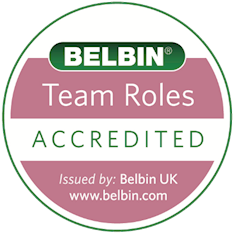Belbin Team Roles

Imagine your manager nominates you for a high-profile leadership development program. You find yourself on a team with four people you’ve never met and know nothing about except that they, like you, are very smart, very driven and management calls them “high potential.” Your team comprises people from different continents and different businesses and who face different customers. You have three months to develop a proposal for an innovative new product or service that you will pitch, as a team, directly to the most senior leaders in the organization. What you choose to develop is up to your team. You have a few days to spend together to kick things off, then you go back to your full time job and must work on this project in your spare time, virtually.
In those precious first few days, what can you do to get your team working together effectively? How can you make sure that your team capitalizes on the strengths of each member – not just in terms of what they know but also in terms of what they can contribute to getting the project done? How can you quickly develop team behaviors or “norms” that enable effectiveness?
Often one team member will bring previous experience to bear and impose that way of working on the team. But innovating with a group of strangers is not a team task or structure that anyone is likely to have experience with. Another way for the behaviors to develop is by gradual evolution, with team members trying out certain ways of working and others responding either positively or negatively. But there’s not enough time for that and the behaviors that tend to evolve that way are typically more focused on the team getting along and getting things done on time rather than about doing innovation better. (Richard Hackman writes about this in Leading Teams.)
In years of forming and coaching these innovation teams we have experimented with various strategies and tools for accelerating their effectiveness. Currently we use the Belbin Team Roles Profile as a first step. (Mohr Collaborative is accredited to administer the Belbin Team Roles profile and to conduct Belbin Team Roles workshops.)
The individual profile requires each team member to complete a 15-minute self-perception inventory and ask six observers to complete a 10-minute assessment in which they select descriptive adjectives from a list. The results rank the team member’s preference for nine “team roles.” These roles comprise specific behaviors that a team needs to function effectively. For example, “Resource Investigators” are good at seeking input from outside the team and building networks while “Completer Finishers” are good at tasks that demand high accuracy and close attention to meeting deadlines. Meredith Belbin’s research showed that teams perform better if they have a balance of all of these roles.
We use the results as one of a number of criteria for forming teams. We also provide the results to the participants and, after a brief foundation in the theory underlying the roles, we coach teams through analyzing their team’s role preferences and planning steps to address imbalances.
Here is why we like the Belbin model:
- It is team focused. It focuses people outward on how they work with other people and how they are perceived, not inward on their own personality traits
- It is results-focused. Rather than starting with personality traits and extrapolating how those might interact on a team, it starts with the behaviors that a successful team needs and asks people how their team can fill those roles
- The underlying research is based on empirical observation. Belbin observed (every 30 seconds!) individual behaviors of teams in management simulations for nine years.
- The results hold up well. Belbin was able to consistently predict the relative performance of competing teams with 80% accuracy.
- The model is intuitive and makes sense without significant background study
- The observer data gives the results credibility and highlights incongruities between the role people perceive they are playing in a team and the role others see them performing. Most people admit that the observer data paints a more accurate picture than the self-perception.
- The inventory is quick – no 375 multiple choice questionnaires – and doesn’t force choices where none of the options apply
- The team roles easily map onto the innovation behaviors we want to foster
We find that teams rapidly engage in a discussion of the tasks that need to get done and who are the best people to do them. They get past the fear of pointing out individuals’ strengths and weaknesses because the discussion focuses on the team and the framework of team roles depersonalizes discussions when conflicts arise throughout the team’s time together. Most important, participants report that the insight they get into their preferences can be immediately applied and has lasting impact on their performance.





Comments are closed.